Not a bad indicator. Might be we’re already starting to go over the fiscal cliff. Probably a lot of contracts delayed pending congressional approval. And the anticipation of higher taxes and lower demand doesn’t help either.
Fortunately for Obama, Romney’s moved the debate away from the economy.
Good news down here is our highly informal polling shows me at 50%+ in my Congressional race! Looking forward to straightening them all out in DC!
;)
FedEx Says Economy Is Worsening, Cuts Outlook
September 18 (Reuters) — FedEx lowered its fiscal 2013 profit target on Tuesday, saying earnings could slide as much as 6 percent for the year, as a weakening world economy prompts customers to shift toward lower-priced and slower shipping options.
The world’s second-largest package delivery company said it now expects profit for its fiscal year, which ends in May, to come to $6.20 to $6.60 per share, below its prior forecast of $6.90 to $7.40 a share.
Wall Street had expected a full-year profit of $7.03 per share.
FedEx’s shares fell 2 percent in premarket trading from Monday’s close on the New York Stock Exchange.
“Weak global economic conditions dampened revenue growth (and) drove a shift by our customers to our deferred services,” Chief Financial Officer Alan Graf said in a statement.

